Table of Contents
The Bureau of Mines has funded an extensive research program to develop improved scrubbers for coal mine applications. This work shows that scrubbers can offer a highly effective technique for dust control during many mining operations. In the most recent applications, these scrubbers are usually mounted on or in the mining machine, and minimum scrubber size is essential for successful installations. Most European applications favor larger scrubbers that are not suitable for machine mounting.
Starting in 1974, the Bureau of Mines designed and tested a family of very small 2,000-cfm scrubbers suitable for various coal mine applications and especially for machine mounting. Dust collection efficiency of these scrubbers ranged from about 88 to 95 pct on respirable-size coal dust. The highest efficiency occurred with a scrubber utilizing a wetted knitted-wire panel similar to the panel used in the scrubber developed by Britain’s Mining Research and Development Establishment.
In 1976 a program was agreed to whereby the Bureau and the British National Coal Board (NCB) would exchange scrubbers to compare the results of laboratory testing. This report describes the results of Bureau laboratory tests of the MRDE scrubber as received, and with a special knitted-wire mesh panel built to Bureau specifications.
Laboratory Scrubber Description
The basic scrubber (fig. 1) consists of a 2,000- to 8,000-cfm vane-axial fan, manufactured by Engart Fans Ltd. (Aberdare , England), a short split (bifurcated) transition at the fan discharge, a 30- by 31-inch by 2-inch-thick panel or mat of 0.009-inch-diameter knitted wire, and a blade-type droplet eliminator. The panel is mounted vertical and thus is perpendicular to the airstream. The electric motor is positioned between the split ducts immediately downstream of the fan. A 7.5-gpm slurry pump, belt-driven from the fan drive, provides sump water at 50 psig to a spray manifold in the fan hub. Makeup water was approximately 10 gph during these tests and was supplied to the sump through a float-controlled valve. Drain slots are installed below the eliminator to drain the slurry water into the sump located beneath the scrubber. The basic scrubber is 51 inches high, 34 inches wide, and 79 inches long, including the fan. Low air volumes through the fan are achieved by external throttling of the airstream.
For some tests the original panel described above was replaced with a similar panel built to Bureau specifications. This panel was 26 inches high, 18 inches wide, and 3/8 inch thick (all outside dimensions). The panel consisted of 32 double layers of commercial stainless steel knitted-wire mesh.
Wire diameter was 0.0035 inch. At 6,000 cfm, measured air pressure drop across the panel was 2.5 inches water gage versus 2.0 inches through the MRDE panel.
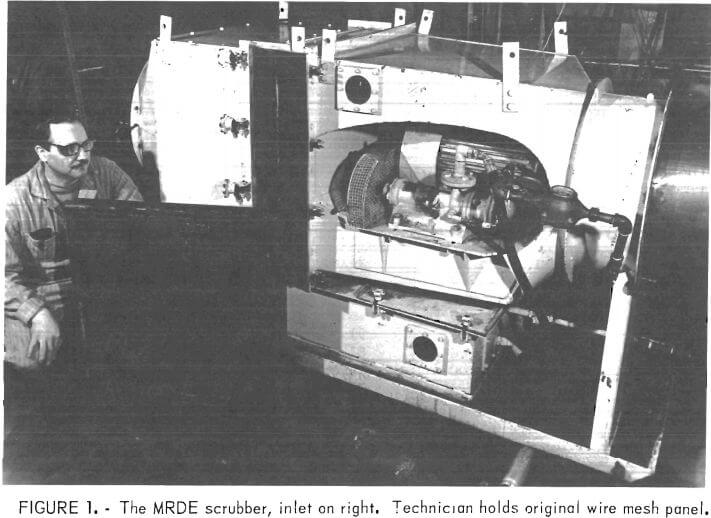
Total maximum air pressure differential across the fan was 13 inches water gage .
The motor was directly connected to the fan and originally designed for 2,920 rpm at 50 Hz. For these tests the power supply was three-phase, 60 Hz, and the motor and fan operated at 3,500 rpm. Voltage was 498, and amperage was 32 per phase maximum.
Comparison of Bureau of Mines and NCB dust collection efficiency results for this scrubber (table 1) shows that the NCB results are higher but indicates reasonable agreement between the two dust-sampling techniques. At a fan speed of 2,920 rpm, NCB reports that efficiencies for this scrubber are 96.0 pct at 3,200 cfm, 95 pct at 4,800 cfm, and 93.5 pct at 6,400 cfm.

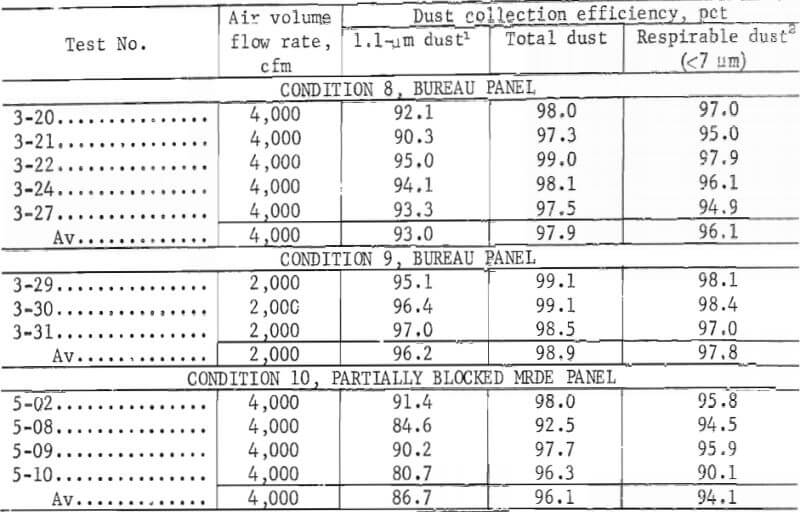
The dust collection efficiency of the MRDE scrubber compares favorably with that of similar scrubbers previously tested at the PMSRC facility. Other select scrubber designs having roughly the same power and water requirements, such as the venturi and flooded-bed types, showed efficiencies ranging from about 90 to 98 pct on respirable-size coal dust with identical laboratory tests.
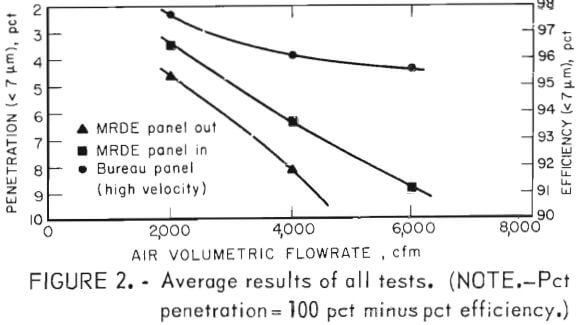 This previous work indicated that for maximum dust collection efficiency, flooded fiber-type scrubber face velocities should be near 2,000 fpm (plus 20 pct, minus 10 pct). Thus, air volumetric flow rates through the scrubber should be held reasonably constant if the face area of the knitted panel is not changed. The minimal charge in efficiency with the Bureau high-face-velocity panel in the MRDE scrubber (fig. 2) may indicate that a panel design with face velocity above 2,000 fpm would offer a higher dust collection efficiency.
This previous work indicated that for maximum dust collection efficiency, flooded fiber-type scrubber face velocities should be near 2,000 fpm (plus 20 pct, minus 10 pct). Thus, air volumetric flow rates through the scrubber should be held reasonably constant if the face area of the knitted panel is not changed. The minimal charge in efficiency with the Bureau high-face-velocity panel in the MRDE scrubber (fig. 2) may indicate that a panel design with face velocity above 2,000 fpm would offer a higher dust collection efficiency.
An additional test series, condition 10, was conducted to help determine whether aerodynamic effects within the scrubber could account for the improved performance of the Bureau media. For this test the original MRDE panel was partially blocked with plywood to exactly simulate the location and face dimensions of the Bureau panel. This would then duplicate condition 8, except that the MRDE panel would be used.
Condition 8 with the Bureau panel showed 96.1 pct efficiency on respirable dust; the MRDE panel, condition 10, showed 94.1 pct efficiency. This strongly indicates that the smaller wire diameter of the Bureau panel improves dust collection efficiency. Previous Bureau tests with a 0.030-inch-diameter wire also support these results.
The performance of the fan used on this scrubber is especially impressive 6,000 cfm is delivered at 13 inches water gage. Unlike many other vane-axial fans tested at PMSRC, there was no tendency to stall even when the flow rate was throttled to 2,000 cfm. The Bureau tests also indicate that this type of fan design might be used to make a small wetted-fan scrubber. At 2,000 cfm, the Bureau tests show that the MRDE scrubber with the panel removed has a significantly higher dust collection efficiency than all other wetted-fan scrubbers previously tested at PMSRC.
No panel clogging or air pressure buildup was observed with either panel during these tests. Maximum particle size in the Bureau test aerosol was approximately 25 µm. Underground coal mine tests with machine-mounted scrubbers using the Bureau-designed panel have had clogging problems. The duct inlet for these scrubbers is located in the auger support frame (boom) of ripper-type miners and picks up a wide size range of particles. Examination of these clogged panels shows that particles roughly 1/16 inch in diameter are frequently embedded within the wire mesh of the panel, and removing these particles can be difficult. The design of the MRDE panel is said to reduce or eliminate the clogging problem.
Laboratory Test Facility
A flow chart of the dust collector test facility is shown in figure 3. Briefly, fine (minus 1/8-inch) Pittsburgh seam coal (1.3 g/cm³) is fed by a vibrator feeder to a commercial pulverizer, which breaks it into a very fine dust with size distribution similar to that of airborne coal mine dust. The pulverizer feeds the dust to an airstream that is then ducted to the scrubber being tested. The scrubber is placed in the center of a horizontal section of duct approximately 45 feet long.
Airflow velocity and velocity gradients within the duct were probed with pitot tubes and a hot-wire anemometer with a special sensor element resistant to damage from airborne particulate matter.
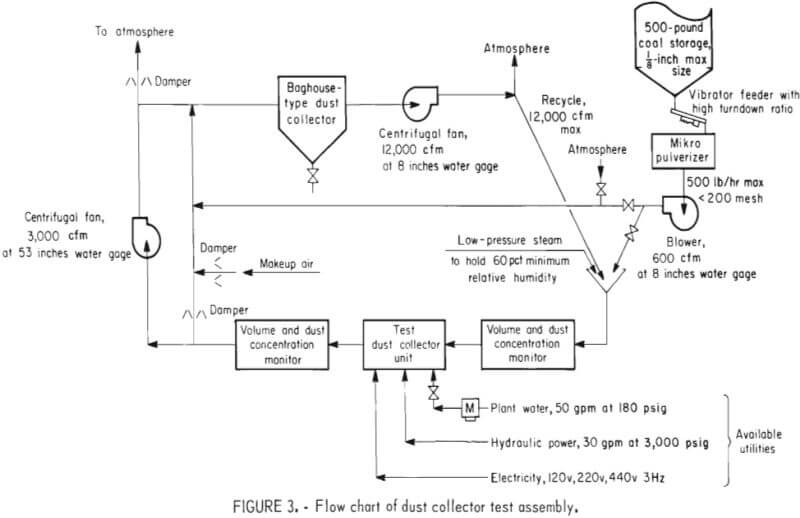
Experimental Procedure
Dust Sampling
The flow diagram of the dust-sampling system is given in figure 4. Iso-kinetic dust-sampling probes are located in the center of the duct, 10 feet upstream and 15 feet downstream of the scrubber. The size distribution of the sampled dust cloud is measured with eight-stage, Andersen cascade impactor ambient samplers. The airflow rate through the Andersen sampler is 1 cfm, the manufacturer’s recommended value. A 1-quart mason jar is used as a water trap upstream of each sampler. Inlet and outlet connections projected 1 inch below the lid.
A preweighed, 80-mm-diameter glass fiber Gelman filter is used to cover each plate of the Andersen sampler to increase the ratio of dust weight to tare weight and reduce dust blowoff from overloaded plates. The filters are desiccated for 30 minutes immediately before weighing.
Most tests are conducted at a concentration between 30 and 60 mg/m³ total coal dust. The total dust concentration into the scrubber normally ranges between two and three times the respirable concentration when measured with the Andersen sampler.
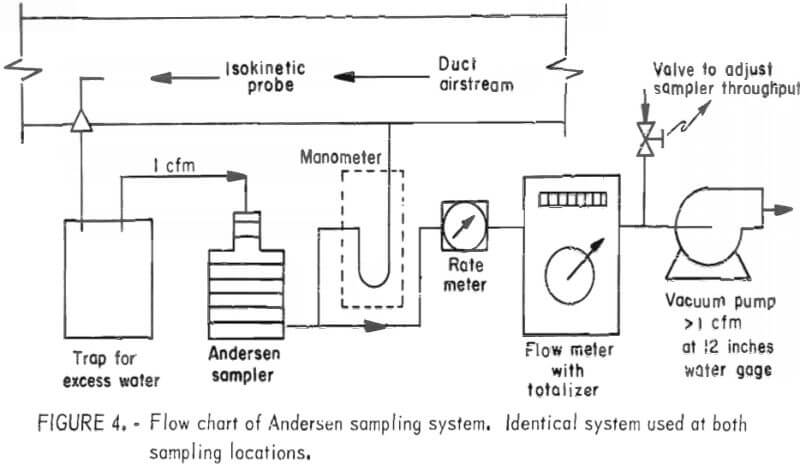
Dust Sampling Analysis
Federal regulations pertaining to coal mine dust are based only on the respirable fraction of the dust cloud, which is defined as the percentage of the particles of a given aerodynamic size that penetrates into and deposits in the human lung. To determine the respirable fraction of a dust cloud, a sampling device usually has an initial or first-stage separator which passes only the respirable fraction.
The respirable fraction of coal mine dust is often determined by an MRE (Mining Research Establishment) sampler, which uses a parallel-plate elutriator as the separator. The MRE curve can be readily described by the formula
Pct MRE penetration = 1 – (equivalent diameter, µm)²/50 x 100
The dust collection efficiency for the respirable fraction of the dust cloud can then be determined from the fractional breakdown data as measured by the Andersen cascade impactor by appropriate application of the MRE curve. (The effective cutoff diameter (ECD) for each stage of the impactor was taken from tables supplied by the manufacturer.) The respirable fraction of the weight of dust collection by each stage is obtained by multiplying the weight by the percent MRE penetration factor for each stage.
A sample MRE efficiency analysis sheet is presented as an appendix to this report. It should be noted that the overall dust collection efficiency of the scrubber given by this procedure is still dependent upon the size distribution of the test dust within the respirable range.
When comparing fractional breakdown efficiency data on various scrubbers, a very rapid analysis can be made by simply checking the fractional efficiency data in the 1- to 2-µm size range. Most fractional data include this size, and good scrubbers will show an efficiency well above 80 pct in this size range. Fractional data in this size range are presented in the results of this report.
The laboratory test facility, dust sampling, and dust sampling analysis are detailed in a previous publication.
Scrubbing Test Results
Ten different tests (conditions) were conducted at air volume flow rates of 2,000, 4,000, and 6,000 cfm. Tests were conducted with the MRDE panel in and with the panel out. (The panel was removed to determine the effect of the wetted fan on dust collection efficiency.) Tests were also conducted with the MRDE panel replaced by a smaller panel built to Bureau specifications. Multiple tests were conducted at each condition, and the average results for respirable (coal) dust collection efficiency are plotted in figure 2. Notable results follow:
- Dust collection efficiency was significantly improved by increasing the air velocity through the panel and using a 0.0035-inch wire diameter in the panel.
- All tests showed that dust collection efficiency decreased with increasing airflow; this decrease was minimal with the high-face-velocity panel. (Face velocity is airflow volume divided by panel area.)
- Most of the scrubbing action at low air volumes occurs in the fan; that is, the device functions as a wetted-fan scrubber. (Previous Bureau studies indicate that blade-type eliminators have little effect on efficiency.)
This Bureau of Mines report describes the results of a laboratory evaluation of a mechanical dust collector (scrubber) suitable for underground coal mine applications. The scrubber was developed by the Mining Research and Development Establishment (MRDE), Burton-On-Trent, England, and tested at the Federal Bureau of Mines Pittsburgh Mining and Safety Research Center (PMSRC) as part of a technical exchange program.
The 2,000- to 8,000-cfm scrubber consists of an electrically driven vane-axial fan, water sprays, a 2-inch-thick, loosely knit stainless steel wire filter panel, and a water droplet eliminator. The dust-laden airstream travels axially through the water sprays, filter panel, fan, and eliminator. Slurry water drains into a sump where a belt-driven pump recycles it back to the sprays.
Fractional breakdown tests showed a maximum dust collection efficiency of 96 pct of respirable-size (less than 7 µm) coal dust at 2,000 cfm. Efficiency decreased with increasing airflow; for example, to 91 pct at 6,000 cfm. Following these tests the original wire panel was replaced with a similar but smaller panel developed at PMSRC; a marked improvement in dust collection occurred at all flow rates tested.
